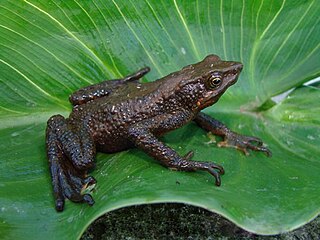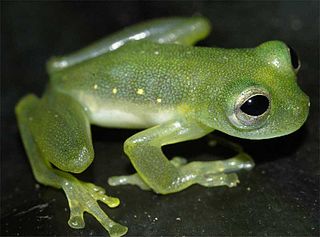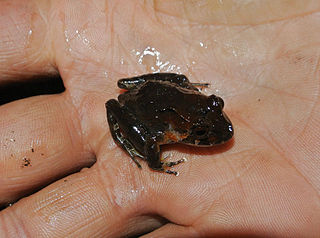
Atelopus laetissimus, the San Lorenzo Stubfoot Toad, is a species of toad in the family Bufonidae. It is endemic to Colombia and only known from the area of its type locality in the northwestern part of the Sierra Nevada de Santa Marta, in the Magdalena Department.

Atelopus nahumae is a species of toad in the family Bufonidae. It is endemic to Colombia and only known from humid montane forest of Sierra Nevada de Santa Marta in the Magdalena, La Guajira, and Cesar Departments.
Centrolene notosticta is a species of frog in the family Centrolenidae. It is found on the Cordillera Oriental in Colombia and on its extension to north, Serranía del Perijá, in the Zulia state in Venezuela.

Teratohyla midas is a species of frog in the family Centrolenidae, which are also known as glass frogs. The species Teratohyla midas was first recorded in 1973 by Lynch, J. D., & Duellman, W. E. This Amazonian species appears to be semi-transparent with gold flecks on its back. Though many species of the glass frog, Centrolendidae, are similar in terms of diet and habitats, they vary greatly among limbs and other physiologies. Because of the similarities between T. midas and other glass frogs, Centrolendidae, researchers often group T. midas together with other species within the same family.
Sphaenorhynchus platycephalus, commonly known as the South American lime treefrog or Lutz's lime treefrog, is a species of frog in the family Hylidae. It is endemic to south-eastern Brazil where it occurs in the Serra do Mar and Serra da Mantiqueira ranges in the states of Rio de Janeiro, São Paulo, and Minas Gerais. However, Araujo-Vieira and colleagues suggests that the Serra da Mantiqueira population could represent Sphaenorhynchus canga; the two species are similar.

Cryptobatrachus boulengeri, also known as Boulenger's backpack frog, is a species of frogs in the family Hemiphractidae. It is endemic to Sierra Nevada de Santa Marta in northern Colombia. The specific name honours George Albert Boulenger, an eminent herpetologist.
Serranobatrachus delicatus is a species of frog in the family Strabomantidae. It is endemic to the Sierra Nevada de Santa Marta, Colombia, and is only known from the Magdalena Department. Common name delicate robber frog has been coined for this species.

Pristimantis leptolophus is a species of frog in the family Strabomantidae. It is endemic to Colombia and known from the páramos of the Colombian Massif and Cordillera Central in the departments of Cauca and Huila. The specific name leptolophus is derived from Greek leptos ("thin") and lophos ("crest") and refers to the low dorsolateral folds of this frog. Common name volcano robber frog has been coined for it.
Pristimantis maculosus is a species of frog in the family Strabomantidae. It is endemic to Colombia and is only known from a few localities in the Cordillera Central in Caldas, Antioquia, and Quindío Departments. The specific name maculosus is Latin for "dappled" or "spotted" and refers to the pale spots on the hidden surfaces of this species. Common name spotted robber frog has been coined for it.
Pristimantis obmutescens is a species of frog in the family Strabomantidae. It is endemic to Colombia and known from the páramos of Cordillera Central in the Cauca and Huila Departments. Common name paramos robber frog has been coined for it. The specific name obmutescens is Latin and means "keeping silent", inferred from the lack of vocal slits or sac in males and the thick skin covering the tympanum. Despite this, the species is reported to call.

Pristimantis permixtus is a species of frog in the family Strabomantidae. It is endemic to Colombia where it is found on the Cordillera Occidental and the Cordillera Central in Antioquia, Caldas, Quindío, Risaralda, Tolima, and Valle del Cauca departments.
Pristimantis piceus is a species of frog in the family Strabomantidae. It is endemic to Colombia and occurs in the Cordillera Central between the Antioquia Department in the north and the Cauca Department in the south. Many specimens are black in color, and the specific name piceus is Latin meaning "pitch-black".
Serranobatrachus ruthveni is a species of frog in the family Craugastoridae. It is endemic to the north-western slope of the Sierra Nevada de Santa Marta in the Magdalena Department, northern Colombia. The specific name ruthveni honors Alexander Grant Ruthven, an American herpetologist. Common name Ruthven's robber frog has been coined for this species.
Pristimantis savagei is a species of frog in the family Strabomantidae. It is endemic to Colombia and occurs on the eastern slopes of the Cordillera Oriental in the Boyacá, Casanare, Cundinamarca, and Meta Departments, as well as in the Serranía de la Macarena. The specific name savagei honours Jay M. Savage, an American herpetologist. Nevertheless, common name Pyburn's robber frog has been coined for it.

Pristimantis simoterus is a species of frog in the family Strabomantidae. It is endemic to Colombia and known from the Cordillera Central in the Caldas, Risaralda, Quindío, and Tolima Departments. Common name Albania robber frog has been coined for it. The specific name simoterus is derived from Greek simos meaning "snub-nosed", in reference to the short snout of this species.

Tachiramantis tayrona is a species of frog in the family Strabomantidae. It is endemic to the north-western Sierra Nevada de Santa Marta, Colombia. The specific name tayrona refers to the pre-Columbian Tairona culture. Lynch and Ruíz-Carranza suggest that this species might have been a model for the gold frogs unearthed from archaeological sites in the area.

Savage's salamander, also known as Savage's mushroomtongue salamander, is a species of salamander in the family Plethodontidae. It is endemic to the Sierra Nevada de Santa Marta in northern Colombia. The record from Venezuela represents another species, likely Bolitoglossa guaramacalensis. The species is named after Jay M. Savage, an American herpetologist.

Centrolene savagei is a species of frog in the family Centrolenidae that is endemic to the Andes of western Colombia, specifically the Cordillera Occidental and Cordillera Central. Its common name is Savage's Cochran frog.
Cryptobatrachus ruthveni is a species of frogs in the family Hemiphractidae. It is endemic to the western flank of the Sierra Nevada de Santa Marta in northern Colombia. The specific name ruthveni honors Alexander Grant Ruthven, an American herpetologist who was the first one to study.

Ikakogi ispacue is a species of amphibian in the Centrolenidae family, which can only be found in the northern Sierra Nevada de Santa Marta, in the department of Guajira, Colombia. It inhabits subtropical forests and is usually seen over vegetation and near streams.












